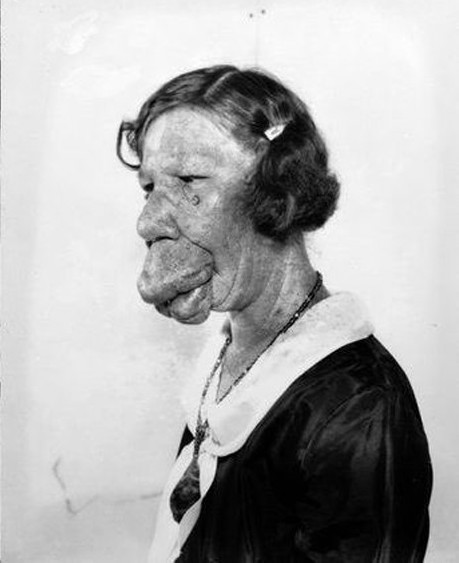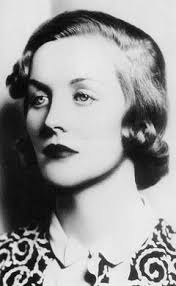

Is there in truth no beauty? (Points to you if you can identify the television how where this comes from and double points if you can identify the original source.) To answer the question, consider the photos inset above.
One is the disfigured face of Ms. Grace McDaniels, born in in 1880, an unfortunate woman who developed a rare facial condition which left her badly deformed. In order to pay the bills and raise her family she had little choice but to find work in a travelling circus as part of their “freak show”. Every dollar she made by offering her deformed countenance to strangers for them to gawk at in horror was needed by her to feed her children.
The other inset face belongs to Diana Mitford, a lovely blonde of classical beauty, born in 1910. She was a sophisticated aristocrat who married Mr. Oswald Mosely, leader of the British Union of Fascists and an admirer of Adolf Hitler.
Setting the two faces side-by-side brings into sharp focus the difference between what St. Paul calls in 2 Corinthians 4:16 “the outer man” and “the inner man”. In this case the comparison reveals that the inner man may be beautiful while the outer man is ugly—and also equally that the outer man may be beautiful while inner man is ugly.
This is hardly front-page news and it has been duly noted in song and literature. We see this in the 1990 song by Northern Pike “She ain’t pretty (she just looks that way)” and also in the 1890 novella by Oscar Wilde “The Picture of Dorian Gray”. In this novella the handsome libertine Dorian Gray remains beautiful with the passing of years while his portrait grew uglier as his sins mounted up, revealing Dorian’s true interior ugliness.
What does all this mean for us as Christians?—apart of course from the obvious lesson that using Botox in an attempt to preserve the outer man is a waste of money. It means that we should take thought for the beauty of the inner man. St. Peter pointed us in this direction already in the first century in his advice to Christian women. In his first letter to new converts he commended “the hidden person of the heart, which is precious in the sight of God” (1 Peter 3:4) as more important to one’s beauty than fancy coiffure, expensive clothes and costly jewellery.
But this apostolic advice has an eschatological dimension to it as well. Every time we knowingly sin—I refer here to deliberate and wilful sins, not to the habitual lapses that attend all human existence—when we sin like this we twist up our souls a little more and defile and deform the inner man. This perhaps explains why in some monastic literature with its reports of visions of demons and angels the demons always appear as unspeakably ugly and why the angels are always beautiful. St. Paul tells us that Satan can disguise himself as an angel of light, but his beauty is just a disguise. Sin is always ugly.
Tragically, some people spend all their lives destroying the inner beauty which was God’s first gift to them when they were made in His image. At the end of their days when they pass from this land of shadows, lies, blindness and self-deception and finally stand before the dread judgment-seat of Christ, they will see their true faces at last, and all the horrors of the inner man will stand revealed. All will see their true ugliness.
It will be the same for those who have spent the days of their earthly sojourn in goodness, doing justly, loving mercy and walking humbly with their God (Micah 6:8)—those who have lived in love and heroic self-sacrifice will be found with their souls adorned and beautified and at the Last Day all their inner loveliness will shine forth for all to see.
In some cases the reversal and contrast between the former outer ugliness and the true inner beauty will be stark indeed. It was of such contrasts and reversals between our present and future state that the Lord said, “The first will be last and the last will be first” (Matthew 19:30).
Even in this age we can sometimes glimpse the coming future beauty. I often say (when asked) that the most beautiful woman I ever met was the grandmother of a friend. The woman’s name was Althea Rideout. Her outer man would win no beauty pageants, for her old face was a mass of wrinkles and her unkempt white hair seemed to fly off in all directions. But Althea was radiant with the love of Jesus. I remember how she once took my newly-converted teen-aged hands in hers, looked me full in the eye and whispered to me like a challenge, “You could be a great soul-winner!” I look forward to seeing her again in the Kingdom and feasting upon the contrast between the old grandmother and the ever-youthful saint.
So: is there in truth no beauty? Are all beauty pageants futile lies? Is a beautiful face and form a mere deception and a snare? No: for all human beauty points beyond itself to the divine beauty, a beauty which will save the world. It looks beyond itself to Jesus, to the time when we shall see the King in His beauty and view a far-distant land (Isaiah 33:17). And this divine beauty inspires us to imitation, to become beautiful ourselves in the inner man—a beauty that will not fade away with the passing of years or even the passing of ages. Eternity is a long time and it begins today. Now is the time to beautify our souls.
